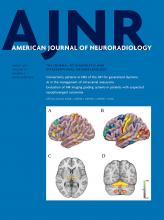Abstract
BACKGROUND AND PURPOSE: There is increasing evidence of abnormal neurodevelopmental outcomes in very preterm infants with low-grade intraventricular hemorrhage grades I and II. Our purpose was to evaluate the effects of low-grade intraventricular hemorrhage on gray and white matter integrity.
MATERIALS AND METHODS: MR imaging at around term-equivalent age was performed in 16 very preterm infants (mean gestational age, 28.8 ± 5.3 weeks) with mild intraventricular hemorrhage on brain sonography and 13 control subjects (mean gestational age, 29.6 ± 4.1 weeks) without intraventricular hemorrhage. Structural and functional evaluation of the cortex was performed using regional measurements of surface area, thickness and volume, and resting-state fMRI, respectively, and of WM microstructural integrity, applying Tract-Based Spatial Statistics to diffusion tensor imaging data.
RESULTS: Compared with the control infants, the infants with low-grade intraventricular hemorrhage had decreases in the following: 1) GM surface area in Brodmann areas 19 left and 9 and 45 right, and GM volume in Brodmann areas 9 and 10 right; 2) fractional anisotropy bilaterally in major WM tracts; and 3) brain activity in the left lower lateral and in the right higher medial somatosensory cortex.
CONCLUSIONS: Very premature infants with low-grade intraventricular hemorrhage at around term-equivalent age may present with regional abnormalities, appearing on imaging studies as cortical underdevelopment, functional impairment, and microstructural immaturity of major WM tracts.
ABBREVIATIONS:
- BA
- Brodmann area
- BOLD
- blood oxygen level–dependent
- FA
- fractional anisotropy
- fALFF
- fractional amplitude of low-frequency fluctuations
- GA
- gestational age
- GABA
- gamma-aminobutyric acid
- GMH
- germinal matrix hemorrhage
- IVH
- intraventricular hemorrhage
- PALSB12
- Population-Average, Landmark- and Surface-Based atlas
- SSC
- somatosensory cortex
- © 2020 by American Journal of Neuroradiology












